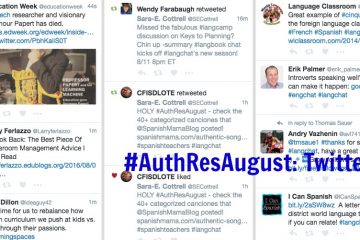The assessments are given and graded, the farewells made, the photographs taken, the materials packed away, and it’s time to sign off, from school, yes – but from what else?
This will be my third summer (mostly) taking the months of June and July as an opportunity to go quiet on the blog, to prepare fall posts behind the scenes and give you less work-related material in your inbox/feed. Last year, I took this step back and added a much farther step back. I did something unprecedented (for me). I essentially signed off of social media for two months. And now, I invite you to join me for a revolution, a #SociallySilentSummer, and let’s see how it changes our year.
Social Media: A real-life horror flick
Let’s talk about social media. Last summer the only time I went on to Twitter was to tweet this excellent op-ed piece from the New York Times calling Twitter “The High School We Can’t Log Off From.” Worth quoting:
It’s the ultimate large box of strangers. As in high school, Twitter denizens divide into tribes and bully to gain status; as in high school, too-confessional musings and dumb mistakes turn up in the wrong hands and end in humiliation.
But it’s far worse than that. Who knows how many years it will be before we know how this revolution has rewired our brains, much less reorganized our society? A former Facebook executive calls social media
tools that are ripping apart the social fabric of how society works.
From psychological research to the top headlines, the warnings are everywhere. From feeding us fake news to feeding us fake sex to feeding us real murder live-streamed for fame and enjoyment, social media’s ills seem to have no end. The stream of pseudo-connection encourages us to spend too much money. It makes us less satisfied and makes us feel socially isolated, and that feeling is linked to early death.
Death.
Indeed, social media may be contributing to the rise in teen suicides.
Death from suicide increased by 56 percent among 18- to 19-year-olds between 2008 and 2017,
says NPR, reporting on an analysis in the Journal of Abnormal Psychology, and the researcher
thinks the rise in smartphone and social media use is a significant factor. By 2012, smartphones had become widespread, she says, and it’s around that same time that social media began to dominate young people’s lives. For example, in 2009 about half of high school seniors visited social media sites every day. That’s climbed to about 85 percent today, with Instagram and Snapchat replacing Facebook as the main “go to social media site,” she says.
And that
it’s known from a body of research that in-person social contact is good for mental health. She questions whether spending that same amount of time on Instagram and Snapchat is just as beneficial, and says “it seems clear the answer is ‘No.’ “
Quite literally, turning away from the screens and to real people – real people who may complicate our lives and make us cry and make us laugh and need us and wake us up in the night – is a matter of life and death. I’d go so far as to say that replacing real relationships with our always-on, never-satisfied media binge, gorging ourselves on every outrage-sparking headline, every potential argument, every unending stream of crazy cat videos, is killing us.
On the other hand, I am thankful for the real-life relationships social media has given me. I’m blessed to have met a great many of you in person, and I treasure the conversations I’m able to have via text, phone, even my personal Instagram, with people I’d consider vacationing with and about whom I’m proud to say “We’ve been friends for years.” Real-life friends.
So, I’m not suggesting we need to abandon social media or die (though I’d wager it’s that serious for some). I’m suggesting we evaluate a healthy way to take a step back from constant connection with people who have never met us and don’t love us and go sip some lemonade in a park with the people who do. Not the occasional get-together-on-the-fly that’s like checking off a box so we can get some photographs to post to our profiles. Actual, no-strings-attached fun. Deliberate. Often.
And what about summer PD?
For me, this is the third summer that also means no professional development. In the summer of 2016, I realized at the end of the school year that I would not be in the same city for two weekends in a row for something like twelve straight weeks. At least half that travel was work-related. Things have calmed down since then, some on their own and some by design, and it’s a pleasant reality. This summer I will not
- attend a single workshop
- give a single presentation,
- track registrations,
- make handouts,
- I may not touch Google Slides for two solid months, and I can’t wait.
This is important for me because I have three small children. If I’m not at a summer PD opportunity, it’s not because I’m sitting on a lounger with a dime novel. I’m drinking in the moments my children are squealing, whining, arguing, laughing, impressing. I’m going to take them to VBS, shuttle them to camp, drag them to the Texas ranch, swim with them in the New England lake. This no-summer-PD thing isn’t a lifetime commitment for me. This is a best-for-us-now commitment. So – see you at iFLT in… say, 5 years?
Total silence? Really?
No, I do make one exception – I have a personal Instagram where I follow fewer than 100 accounts, most of which are either personal friends (sorry, teacher friends who have found me there – no #teachersofinstagram material from me) or accounts like the local zoo and my favorite coffee shop.
What I’m saying is, again, evaluate a way to really step back. I almost said “realistically” but I know how easy it is to say, “But I can’t cut ______.” But I can’t delete all my Facebook friends. (Yes, I did that several years ago.) But I can’t not tweet for that long. You can. In fact, I’d encourage you to pick something you think is really going to hurt, really going to be hard, and be surprised at how it’s really just not.
Along those lines, Forbes has several great suggestions especially for those involved in a lot of meetings, and The Guardian suggests
adaptation can be incremental. Start by switching off smartphone alerts, or taking social media apps off your phone, then switching off the device for increasingly long periods.
In a blog post called “This will take two hours,” Seth Godin described how our usual output media are not designed for deep thought:
We have Slack, which is optimized for, “yep, I saw that.”
We have email, which is optimized for, “I cleared my inbox” or possibly, “I’ll do this later.”
We have Twitter, which is optimized for wasting time.
And we have Facebook, which in only a few minutes, can make you feel left out.
Godin thinks we need some convention for something that could take hours, to help us say
I’m ready to think deeply and work hard and change my posture and truly engage with this idea now.
Where can we agree?
The general consensus is this: Digital anything is no substitute for real relationships.
My favorite YouTuber, travel guru Alan, recently wrapped up a trip to Bali. In one of his latest posts, he wrote about how what’s all the rage around Bali is “Instagram spots” – places where so-called influencers (I hate this word) wait in line for hours – not to feast their eyes on classical art, not to literally feast on sumptuous delicacies available nowhere else, not to take an exhilarating ride down a highly-rated zipline – but to take an Instagram picture. Alan had done the same thing, and honestly, the picture was very cool. But it didn’t sit well with him. One of the reasons I love following Alan is that the travel has always been about the people and the moments to him. He’s never been about more stamps in the passport or even counting the number of countries he’s visited.
In Alan’s next post, he declared the end of his journey to Bali and a break of unspecified length from his YouTube channel. The Instagram / YouTube picture is not the only one or often even the correct one.
Perhaps Alan realized that social media has helped us turn our natural desire for approval and accomplishment into a never-ending comparison of likes, followers, numbers, badges, stamps, miles. But it’s not never-ending. It does end. We’re all going to die, and it could be tomorrow – and if that’s the case for me, very few of the people who follow me on Twitter would even notice. This June and July, perhaps every June and July, I’m choosing to spend the majority of my time focusing on the people who would.
See you in August, friends.


